Here’s a glimpse of a recent fortnight in Shangri-la.

As is often the case my brother and his wife come for a visit, now extended from one week to two weeks since they are now both retired. I guess that is a commentary of sorts, with my siblings and I all retired including the baby. We are fortunate in that all five of us get along famously and maintain a steady text thread keeping us up to date with each other. The thread activity really ramped up when our Mom was in her final decline a few years ago and it never stopped.

Anyhow, you might remember the post a few months ago about trolling for firewood on the homestead, with a special emphasis on existing windfall waiting to be harvested. Of particular interest this week was the cluster of storm damaged locust trees up at the top of the hill, with several large trees down and tossed about. FYI locust is a highly prized firewood, very BTU dense with a hot burning temp and less ash than other woods. When we got down to it, we realized that in addition to the already-dead trees there were at least a half dozen still-standing (but probably not for long) locusts that could/should come down.

So down they came. It took some forethought as the trunks were intertwined and needed to come apart in a particular order. My brother is really good at that work. By the time we finished the week there were four heaping trucksful of sawn and split firewood to stack up at the barn.

At this point I am well into the firewood inventory for Winter 2026/2027, but I still have a lot of windfall to harvest. By my guess it will be about ten truck loads, so all is good. I will work on those truckloads in between other stuff over the winter. It’s gonna be crazy with grandson #4 due probably next week.
Things have been popping in the orbit of Shangri-la, what with summer gardening (soon to be complimented with winter gardening), visiting the grandsons (and their parents), preparing for the upcoming woodfinishing workshop and historic trades fair, and a multitude of other stuff disrupting my writing and blogging routines.



The greenhouse is currently the home for a series of Self Irrigating Planters Mrs. Barn asked me to create for her. We built five different versions and in keeping with her background as a plant scientist she was conducting a standardized experiment to determine which version is the one to go with in the future. We plan to use SIPs almost exclusively inside the greenhouse so her efforts are well worth it.
These images are from a month ago, so the plants are all bigger now and burgeoning with tomatoes or eggplants.


In addition to the greenhouse experiments she’s been harvesting the seeming bushels of green beans we love so much. Nothing quite like fresh green beans, and her dilled beans are the best.

The asparagus season is long in the rearview mirror but was savored intensely in its time. The asparagus plants are now full-blown bushes about ten feet tall. Mrs. Barn sez this is one of the keys to keeping an asparagus bed thriving. She must be right, ours is many years old.
As for all the other activities, stay tuned.

Things are getting closer to wrap-up with the greenhouse project, as I built the steps on the bank from the yard up to the terrace. I will probably build a second set of steps at the other end, but we are really getting close to the point where we can say we have a first-class functioning greenhouse. This was an “in process” image, the steps are now all done and a great addition to the endeavor. We no longer have to trek diagonally across a steep bank that is frequently slick with dew.

A couple weeks ago I followed Mrs. Barn’s protocol and covered the entire floor with cardboard once she had settled on a configuration for the space. This step really cuts down on weed encroachment once it is covered with a layer of mulch.
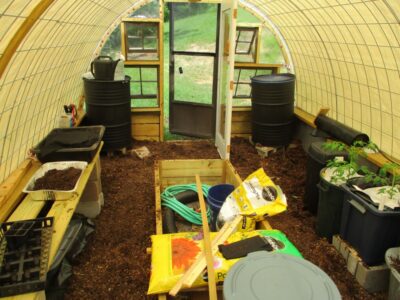
I also placed four black painted drums in the space, one in each corner. Once I install the spigot kits near the bottom of each drum they will serve two functions. First is to provide water to the plants since there is no hard plumbed water line, so these will have to be refilled by hose on occasion. Second, though, is to serve as heat sinks in the winter when the black paint and water inside the drum is heated in the winter time to keep the overnight temps moderated. At least that’s the plan. I also may wind up putting more thermal mass in the space, such as sand-filled concrete blocks painted black to absorb solar warming.
With that all done I hauled up a truckload of mulch to cover the carboard on the floor. It transforms the space visually and functionally as sometimes walking over layers of cardboard is a slippery proposition.

I will shortly add some benches to the covered-but-not-enclosed end of the structure where many plants will be kept as a intermediary space.
Our noodling between now and winter will be to get a handle on temperature controls for both heat and cold. Even though the enclosed space has a shade cloth over it the temperatures on a sunny day can get pretty extreme inside, much more than our one little 12-inch fan can handle. I’ve got another fan on order, and hope that two will do the trick. I am not pleased and cannot recommend the one we bought, but it is here and installed and works, some of the time.
The next update from the greenhouse will focus on Mrs. Barn’s experimentation with self-irrigating planters.
Stay tuned.
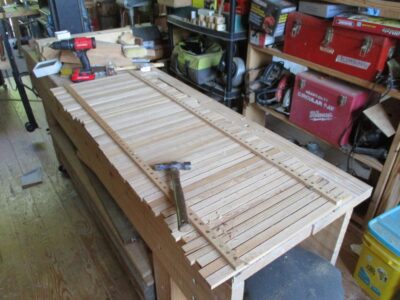
Prior to fabricating and installing the new Coanda-style cover for my hydroelectric capturing box, every couple weeks I would notice a drop-off in the water flow to the turbine. Sometimes it stopped altogether. So, I had to turn off the water at the bottom, flip up the turbine housing and remove the nozzles. Invariably the orifice was crammed solid with a crawdad body, sometimes compressed to the point where I needed to drive it back out with a metal rod. It happened so much I kept a tool right there for the task.
With the former configuration the intake was covered with 1/4″ inch hardware cloth, even then the little crustaceans figured out how to get into the capturing box and were sucked into the pipeline. A minute or two and 1200-feet later they wound up crushed at the bottom when their carcasses were too large to fit through the turbine nozzles. Hence the need for regular clean-out.
Since I installed the new cover there have been zero crawdads in the nozzles. .
A big step forward.
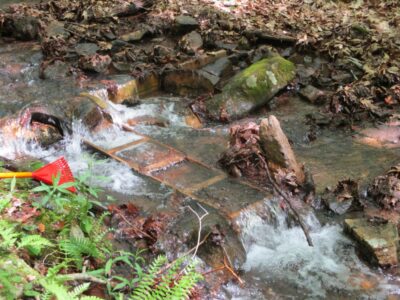
Although I’m not back in the shop full time or anything close, I did sneak in a couple of sessions to make and install the new cypress lid for the hydropower capturing basin. Last winter I saw that something had torn the living starch out of the previous hardware-cloth-over-frame lid, rendering that element useless in filtering out the debris. It was probably a bear, but I really have no idea why a bear would feel the need to tear up the box lid in the middle of a vigorously running stream. The box itself was uninjured, perhaps because it holds about 500 pounds of rocks.
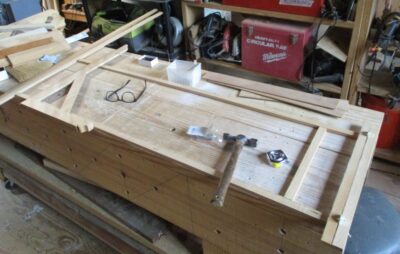
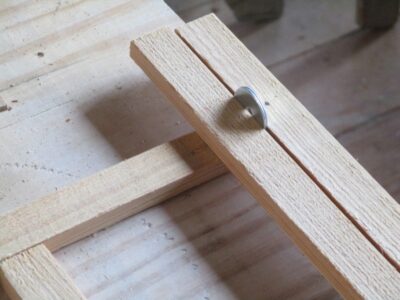
My first step for the new lid was nailing down the side strips to the workbench, then began nailing on the slats spaced two washers apart. This will result in a roughly >1/16″ opening, large enough for the wicking of water through the lid but keeping out the debris and crawdads. I nailed it all together from both sides with copper slatters nails, driven into pre-drilled holes. Once the unit gets saturated the wood will swell and clinch the nails solidly in place.

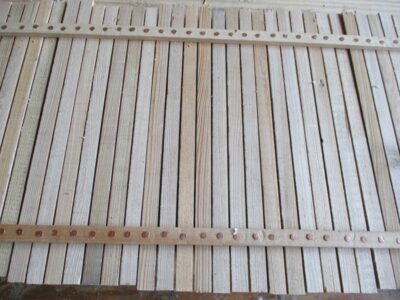
This particular structure is known as a Coanda Screen, although they are usually manufactured from stainless steel rods and screens.
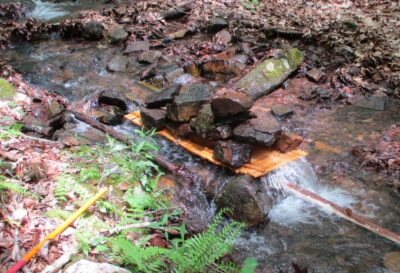
A hike up the hill to clean out the debris from the capturing basin and setting the new lid in place and the system was functional once I made the penstock re-connection that I disconnect when winterizing it. I added another 500 pounds of rocks on top to discourage any four-legged vandals. We’ll see if it works.
Over the summer I will spend a few days working on the penstock incline, building rock berms to flatten out the swales so that maybe, just maybe I can keep it running all winter long. Enclosed water lines can supposedly keep running down to -17F if there is minimal turbulence.
But for now, after a week of vigorous rain (~3″ total) it’s pounding out the power.
Back to finishing up the myriad details for the greenhouse.
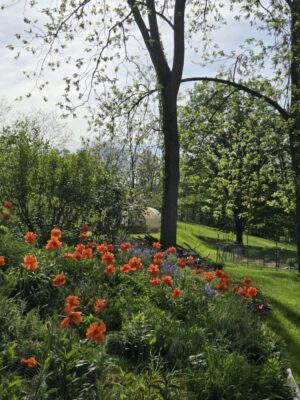
As I continue working on the multitude of details getting the greenhouse ready, Mrs. Barn’s flower garden, carved out of the rocky hillside next to the cabin, has erupted in an explosion of colors as the poppies have burst onto the scene. In a couple months the daylilies will emerge, and in between will be a host of other rainbows of flowers I know nothing about beyond appreciating their beauty. To say that she revels in the beauty of nature and especially flowers would be an understatement. Today is our annual Mrs. Barn’s Birthday Safari to Millmont Gardens to load up with beautiful plants. She has free reign to get whatever she wants, the space in the back of the CRV being the limiting factor.
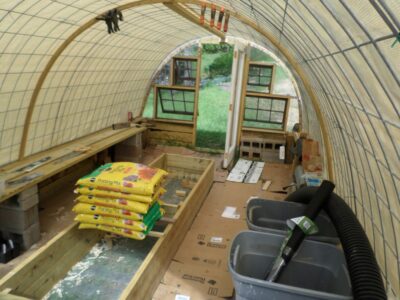
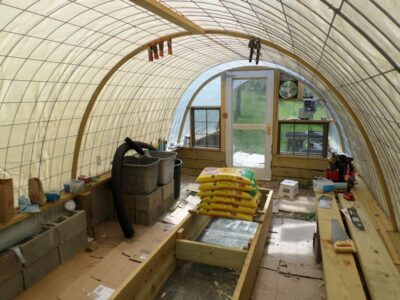
As for the greenhouse itself, we have begun to finalize the interior layout and some seedlings are underway. I have removed much of the construction supplies and tools, bringing a sense of order to the space. Lately we have been scouring the University of Youtube to garner the best information on building self-watering planters.

We have passed through asparagus season, having freshly-picked shoots with almost every meal for more than a fortnight. The bed is now proceeding to the “bush” phase and in short order the asparagus bushes will be 8-10 feet high. She says this is the key to an established perennial asparagus bed, and since it has worked here for two decades I rely on her judgement.

I can just now glimpse returning to the workbench on the horizon. First project is to make a new, sturdier cover for the hydro capturing trough that a bear (?) tore up last autumn.
After what seems like a century we are back in Shangri-la, having logged thousands of miles in traveling for the past two months. We were home twice to swap out luggage but otherwise we were elsewhere.
It began with our arrival in DC for the very birthing day of Grandson #3. Three weeks later we went to Alabama for the third birthday of Grandson #1 and first birthday of Grandson#2. Then back to DC for GS#3’s baptism, a grand week we got to spend with our co-in-laws. My co-father-in-law and I are twin sons of different mothers.
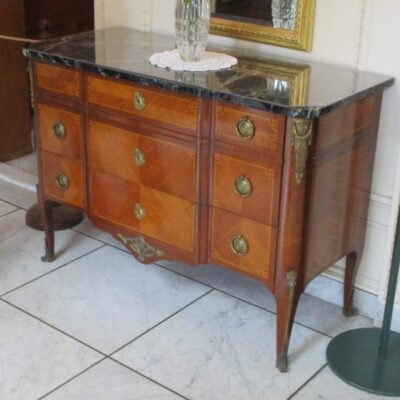
While in Rochester our hostswe squeezed in a visit to the Eastman House museum. This was a charming veneered French-style chest, although almost certainly late 19th or early 20th century (I did not take it apart to confirm that thought). I was especially taken by the “knotted banding” pattern.
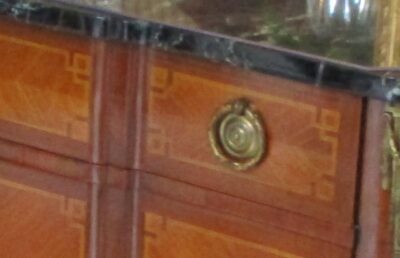
After another brief stop to swap out more laundry we wrapped up our journeys with a trip to Rochester NY where I made six presentations to the Rochester Woodworkers Guild — Principles of Furniture Conservation, Case Studies in Furniture Conservation, How Furniture Conservation Affects My Current Furniture Making, demonstrations of various conservation techniques, a review and demonstration of parquetry techniques, and finally a conservation/restoration clinic based on the pieces the attendees brought with them for that purpose.
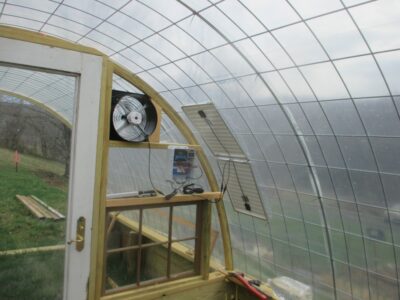
Now back home with summer trying to ramp up we are back at it big time. Mrs. Barn is feverishly working on her gardens and I am hard at work on the greenhouse, finishing the installation of a greenhouse fan, draping the structure with a shade cloth our newest son-in-law gave to us when it turned out to be too large for their patio space, and sealing up the perimeter to protect from the voles that are the bane of Mrs. Barn’s gardening life.

The shade cloth was something we had been wondering about as the inside temps were in the 80s when the outside temp was in the 20s. Now that the sun and outside temps are much higher the issue came front and center. I do not like high temperatures anyway, but when I was working inside the greenhouse in 110-degrees I broke out the shade cloth and affixed it in place. Combined with the fan that lowered the inside temps to a manageable 85 degrees.

Even though the 1/4″ hardware cloth covers the entire floor out to the walls, I made a second hardware cloth “flashing” to be ground-stapled on top of the continuous layer then crown-stapled to the walls. The tricky part is forming it to the posts, which usually required another piece or two to be cut and fitted. If voles get past this a number of Rat Zappers will be awaiting them.

As for vole-proofing the space, that began at the very beginning of the construction phase several months ago. I covered the entire inside space with 1/4″ hardware cloth, and now was the time to tie it all together with new pieces at the bottoms of the walls and posts. One more day of that and it will be time to move on the laying out the inside configuration.
I hope we get to stay home more from now on, but that may be a vain hope. In two months the family of GS#1 and GS#2 will be moving to live within five miles of GS#3. I’m guessing that Grandma and Grandpa will be burning up the roads between here and there.
I am anxious to get back into the shop to work at both the bench and in my writing chair, but that might have to wait a little longer.
This is a bit of an explanation as to why the blog has gone dark for three weeks or so.
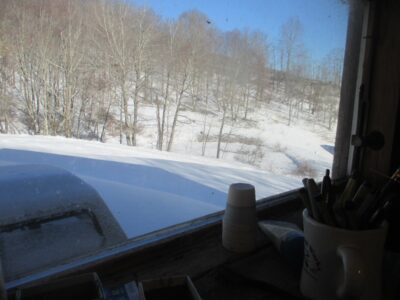
Three and a half weeks ago the weather forecasters shocked the snot out of us by getting the “what, when, and how much” guesses right on the mark. I mean dead in the bulls-eye. We got the “eight to fourteen inches of snow” exactly when they predicted.
The next morning I fired up my monster snow blower and got to work. I was thinking it would take me two or three hours to get the driveway and parking spaces cleared. At the end of my first trip to the cattle gate at the entrance to the driveway down by the road, the blower snapped both of its auger/blower drive belts. Okay, I’ll just go into town and get a couple more.
Mrs. Barn and I did just enough shoveling to get my truck off the property and into town. Unfortunately, my experience was replicated many times in the county as this was the first time in four years we needed to get out our snow blowers, and a lot of them broke their belts on the same day. As a result there were none in town. Anywhere.
Okay, I’ll find some close by on the interwebz so it can be here the next day or two. Alas, my phenomenon was apparently replicated thousands of times across the mid-Atlantic and none were close by. Eventually I found a place in Milwaukee that had them “in stock.” It’s been three weeks and they have yet to arrive.
Meanwhile, we spent dozens of hours shoveling the driveway and parking area by had so that life could proceed with little further disruption.
This was not the worst snowfall we’ve seen since buying here 25 years ago. I remember planning to come for a long weekend in maybe 2009(?) or thereabouts to work on the barn, and when I checked with my pal Tony he told me not to bother. “The snow is as deep as the top of the cattle gate. You aren’t getting in.” Two weeks later I got in, no problem.
You see, our normal weather pattern is for a storm front to come through and dump some snow, followed by a couple very cold days, followed by a couple weeks of mild (above freezing in the daytime) weather.
Not so this year. Yes, we had a storm front with the snow, exactly how much is unknown because the howling winds moved it a bunch even after it fell. Yes, I saw and shoveled snow that was 8-inches deep. But, I also saw and shoveled snow that was more than a foot deep.
Patiently we waited for the mild weather to return and take care of the snow cover on the driveways.
It never came. It still hasn’t
Once we started getting the long range forecasts for last week and this week I knew we were in trouble. If it got as cold as predicted we would be using a week’s worth of firewood every day. Every day.
Fortunately I had about half of next winter’s firewood already cut, split and stacked. Unfortunately, it was up next to the barn. This meant I had to get a truck up to the barn to retrieve it. And for that to happen, the whole driveway to the barn and much of the parking area next to the barn had to be shoveled by hand so we could replenish our firewood inventory at the cabin.
So I did. Shovel the complete driveway. This meant that from beginning to end I/we shoveled almost a quarter mile of driveway. By hand. Much of it twice as there were several subsequent weather fronts coming through dropping more snow. Sunday’s yield was 5-6 inches, fortunately light fluffy snow so the shoveling was easy and (comparatively) fast. Still, I would guess that in the ten days between two weeks ago and yesterday I estimate 50 hours with my hands on the shovel. I make a point of going slow and steady. Almost every night I was almost asleep by the time supper was over.
This is by far the most and longest-lasting snow cover we have had in our years here. This coming weekend we will have a few days at or above freezing, with sunshine, and that should cure all the ills. It follows two really cold weeks, including this REALLY cold week with five consecutive nights near or below zero at night. This morning was -10 when I checked at 8AM. We haven’t used a week’s worth of wood per day, but still it’s been a lot. Around a dozen arm loads per 24 hours rather than the normal half dozen.
All that Light has been why the blog has been dark.
My recent post about apple butter making was an account of a “public” event at our friends Pat and Valerie’s place a month ago. A couple weeks ago we learned that there was going to be a second episode of apple butter making, this time pretty much restricted to a close circle of friends. We are, fortunately, part of that circle.
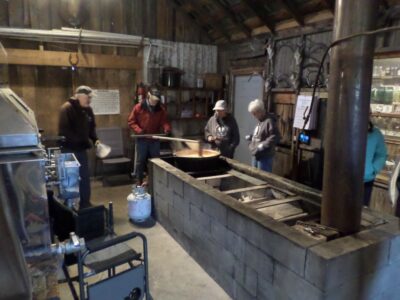
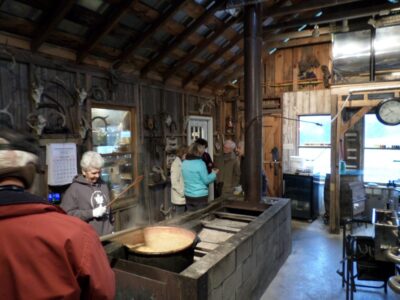
The appointed day for the apple butter rendering was a brutal cold, raw, windy and rainy day. In response Pat and Valerie set up the cauldron inside their boiling hearth, normally holding the sugar water boiling pan for making maple syrup. Being a creative guy, Pat removed the pan and rigged up his cauldron with a propane burner to cook the apple chips. Or maybe it was Valerie’s idea, I don’t rightly remember.
This made the entire event even more charming and cozy.
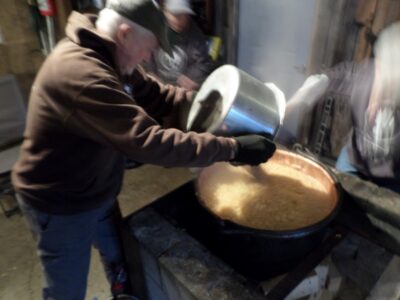
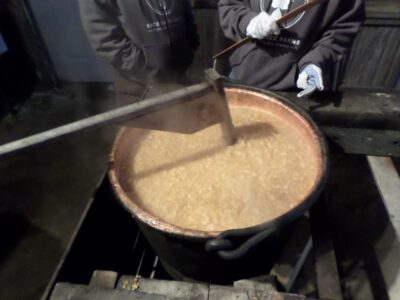
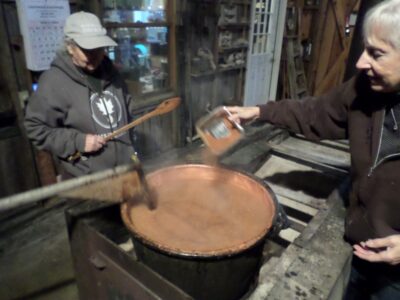
So there we were in this homey setting, stirring and adding apple chips to the bubbling cauldron until after several hours it was time to add the spices. Normally sugar would also be added but this batch of apples was so sweet naturally none was needed.
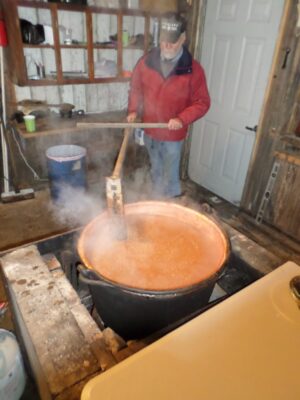
The spices were stirred in for another half hour.
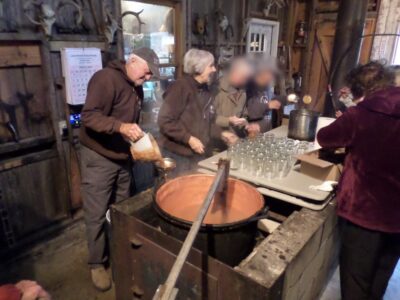
At the proper time the canning began with a well-honed assembly line. Once again my task was to take away the full cases loaded with the still-hot apple butter.
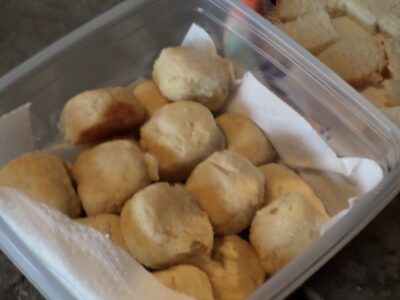
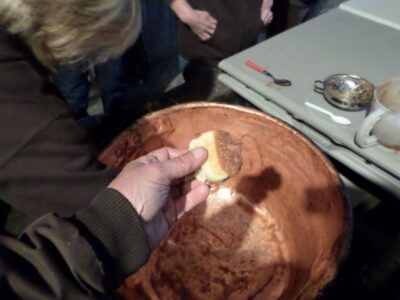
Out came the fresh biscuits, made with loving excellence by Pat’s sister. The scrumptious biscuits were used to clean out the cauldron. Yummmmm.
Another day well spent.
The time was fast approaching when I could button up the wire frame tunnel, wrapping it with the 6mil greenhouse plastic.
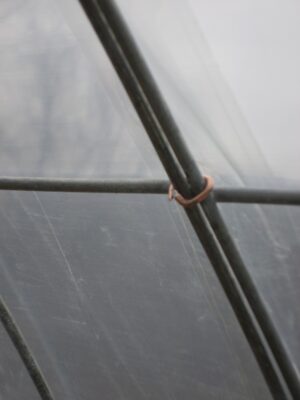
First, concurring with reader EarlM, I secured al the wireframe panel edges with hog rings along the joints. Yes, zip ties are not what was ultimately needed but sufficed for the initial assembly, but the metal hog rings were necessary for the long haul. Addressing the issue of stable edge joints was paramount as the ongoing vibrations of wind against the wire/plastic would eventually breach the film membrane. Not good. However should that ever occur I can repair it with special tape made for that purpose.
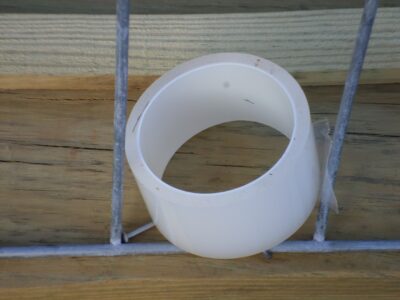
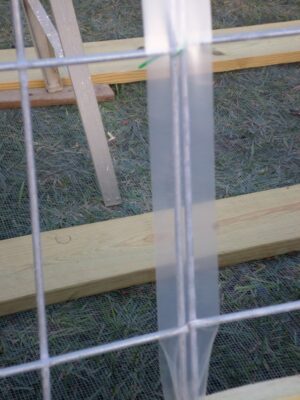
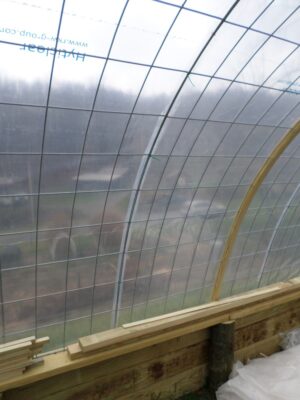
And speaking of tape, I decided to cover the edges and hog rings with Ace Hardware store brand heavyweight packing tape. It is not very good for packing cardboard boxes but really excelled at this application. Two layers of the thick transparent tape had me ready for the final step of this episode — draping the whole thing with the plastic film and affixing said film to the edges of the wooden structure.
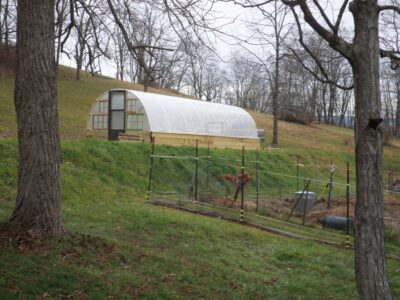
I’d arranged for my friend Boyd to come over to help, and he was a great help with excellent ideas on how to actually do the task.
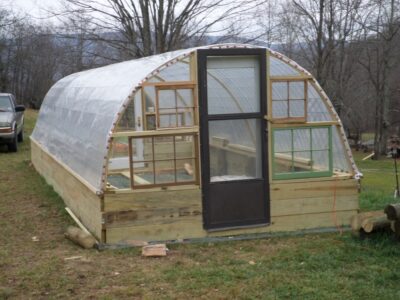
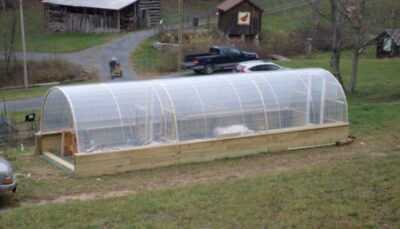
I spent the next few hours tacking down the edges to secure the lid. Not all of it was aesthetically exquisite, but it has been holding fast through some pretty fierce winds already.
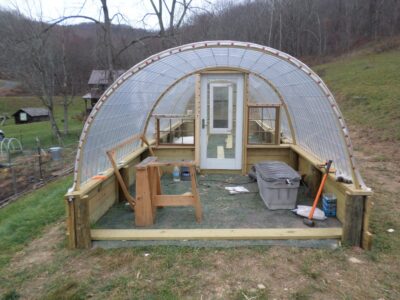
It’s beginning to look a lot like greenhouse, just in time for Christmas.



















































Recent Comments